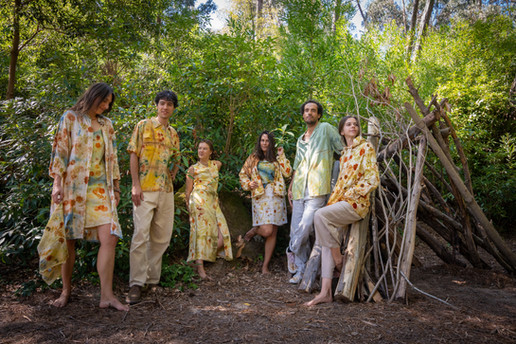Seasonal Profile: Summer Garden Plants
- annettebrinckerhof
- Oct 16
- 3 min read

Plant Spotlight
Coreopsis (Coreopsis tinctoria)
Native to North America but widely grown in gardens, there are dozens of varieties of Coreopsis. The one I grow in the garden is Coreopsis tinctoria, a historial dye plant to indigenous North Americans. The full plant has dye and printing potential producing warm yellows, bright oranges, rusty reds, and even dark greens or browns depending on mordant and concentration. It’s a pollinator favorite, feeding bees and butterflies throughout summer. In the dye pot, it embodies the heat and brightness of the season and the printed flowers are practically photographic.
Cosmos (C. Bipinatus and Sulfuris)
Both varieties of Cosmos are staples in an ecoprinters garden, both for the flowers and foliage. Native to the Americas, there are dozens of varieties and subspecies. The pink cosmos bipinatus are often planted in gardens around the world. They grow extremely quickly and will start easily from seeds that fall. The foliage gives yellow to green colors and the Sulfur cosmos flowers print orange while the pink Bipinatus flowers print surprising blue-teal colors!
Scabiosa (Sabiosa atropurpurae)
Scabiosa atropurpurea (the variety I grow in the garden) is a cousin to the wild knautia species native to Portugal which can be found growing in disturbed soils and meadows - with a much lighter color flower closer to lavender. Scabiosa gives an intense punch of color that ranges from blue to green and is extremely sensitive to changes in pH. It grows easily and gives an abundance of flowers which I save and dry for a confetti-like effect.
Marigolds (Tagetes patula & erecta)
The most widely recognized plant I grow in the garden. Native to the Americas (particularly known in Mexican culture), it has been widely naturalized all over the world and is now iconic to Hindu ceremonies in India. This is why in Portugal the comon name is 'Carnation from India' despite note being native to the eastern hemisphere. In Portugal it's most known for its popular edible flowers and the strong smell helps to repel pests in the veggie garden. In the summer collection, she provides an intense golden yellow color dye and abstract prints.
Indigo (Persicaria tinctoria)
Indigo Blue - the signature color of the summer collections. Cultivated and processed in-studio, it connects me to centuries of indigo tradition in a healing way. Although I grow 3 species on indigo bearing plants (Isatis tinctoria, Indigofera Autralis + Sufruticosa, and Persicaria tinctoria), it is Persicaria tinctoria (Japanese indigo) that I use for production. As the name suggests, Japanese indigo is the annual plant most used in Japan for blue in their sukomo process.
To dye with indigo is unlike any other dye plant. A completely universe by itself. Because the pigment is not soluable in water, it must go through a reduction process that first turns the fabrics a yellowish-bronze color which oxidizes to blue when in contact with the air.
Concept and Inspiration
When the spring weeds dry up and the days get longer, the garden comes alive in an arrangement of reciprocity. In the Summer season, I have the most involvement with the plants. In addition to edible and medicinal plants, I grow a variety of dye plants that are not native or wouldn't be sustainable to harvest from the wild. I have the privilege to follow these plants from seed to fabric and they teach me so much about stewardship. I care for the plants, and they in turn provide color, fragrance, and joy. Redifining the relationship between humans and their surroundings in a way that is beneficial for all.
The Summer collection starts well before in the Spring. Starting the seeds in March months before they are harvested and color is transferred to fabric and finally composted. After the season is finished, garden maintenance continues as flower beds get put to rest. Because of this year-long care, I am able to dye with an abundance of bright colors in the summer.
The pursuit of bright colors like reds and blues have been the source of a lot of natural dyeing's violent past. By growing these plants that give rare, bright colors following regenerative agriculture principles that prioritize building soil health and regenerating the land, I heal my relationship with the past of my craft.





































































































Comments